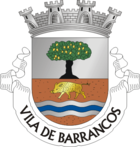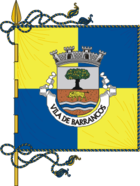Barrancos
| Barrancos | ||||||
|---|---|---|---|---|---|---|
|
||||||
| Basic data | ||||||
| Region : | Alentejo | |||||
| Sub-region : | Baixo Alentejo | |||||
| District : | Be yes | |||||
| Concelho : | Barrancos | |||||
| Coordinates : | 38 ° 8 ′ N , 6 ° 59 ′ W | |||||
| Residents: | 1841 (as of June 30, 2011) | |||||
| Surface: | 168.42 km² (as of January 1, 2010) | |||||
| Population density : | 11 inhabitants per km² | |||||
| Barrancos district | ||||||
|
||||||
| Residents: | 1841 (as of June 30, 2011) | |||||
| Surface: | 168.42 km² (as of January 1, 2010) | |||||
| Population density : | 11 inhabitants per km² | |||||
| Number of municipalities : | 1 | |||||
| administration | ||||||
| Administration address: | Câmara Municipal de Barrancos Praça do Município 2 7230-030 Barrancos |
|||||
| President of the Câmara Municipal: | Dr. António Pica Tereno ( CDU ) | |||||
| Website: | www.cm-barrancos.pt | |||||
Barrancos is a small town ( Vila ) in Portugal with 1841 inhabitants (as of June 30, 2011). A not officially recognized dialect is spoken here, the Barranquenho .
The place is known for its wine and its notorious bullfight in Portugal.
history
The area had been settled since the Copper Age. It was part of the Roman province of Lusitania and then the Visigoth Empire and then the Arab al-Andalus . During the Reconquista , Gonçalo Mendes da Maia conquered the castle of Vila de Noudar from the Arabs in 1167 . Noudar received its first town charter ( Foral ) in 1295 and was elevated to Vila. In 1303 the order of knights of Avis received the area. In 1513 King Manuel I renewed the city rights of Noudar. The nearby town of Barrancos grew, while Noudar continued to lose population over the years. In 1825 the Vila de Noudar ceased to exist and the district finally moved to the nearby Barrancos. From 1896 to 1898 Barrancos was briefly part of the Moura district, only to be an independent district again since then.
Culture, sports and sights
Barrancos is known for its red wine and especially for its protected Iberian pork ham , here often referred to as Porco de pata negra ( Portuguese for: black- clawed pig ) or Porco de raça alentejana ( Portuguese for: Alentejo breed pig).
For Barrancos there is a legal exception in Portuguese bullfighting , so that here the bull is also killed.
In addition to the city museum ( Museu Municipal ) there is also an archaeological and ethnographic museum.
Founded in 1982, the Barrancos Futebol Clube football club plays its home games in the 500-seat municipal stadium Estádio Municipal do Baldio . He competes in leagues of the Beja district association (as of 2013/14).
In 2011, the Barrancos Futsal ADC lost the final for the championship of the district association of Beja in futsal , the indoor football popular in Portugal.
Natural park
In the district of Barrancos is the fortress of Castelo de Noudar , which is located in the natural park of the same name. The nature park belonging to the “Herdade da Coitadinha” estate was officially opened on March 21, 2006. The main aim of this initiative is to preserve ecosystems that have been threatened by the nearby Alqueva dam . The park is located within a protected area and forms an ecological unit with other natural areas in Spain, such as the "Serra de Aracena", "Picos de Aroche" and "Serra de Hornachuelos" nature parks.
Castelo de Noudar
The fortress Castelo de Noudar is located high above the Ardila River and the foundation walls were built during the rule of the Moors . With the reconquest by the Christians in 1167 by the warlord Gonçalo Mendes da Maia, the castle went to King D. Dinis (1279 to 1325). The castle was handed over to the Avis Order around 1300 and the expansion was completed around 1308. In 1707 the castle and the associated village were occupied by the Spaniards during the War of Independence. The return to the Portuguese crown was sealed in the Treaty of Utrecht on February 6, 1715. Today the castle is protected as a national monument of Portugal and has been owned by the district of Barrancos since 1893. The building with 12 towers, 18 meter high walls and two still intact cisterns is very remote in the middle of the nature park of the same name.
administration
circle
Barrancos is the seat of a district of the same name. The neighbors are Spain to the north and east and Moura district to the south and west .
The district of Barrancos is one of the six Portuguese districts that consists of only one municipality ( freguesia ).
Population development
| Population in Barrancos County (1801–2011) | |||||||||
|---|---|---|---|---|---|---|---|---|---|
| 1801 | 1849 | 1900 | 1930 | 1960 | 1981 | 1991 | 2001 | 2011 | |
| 2 094 | 2 042 | 2,659 | 3 210 | 3 429 | 2 157 | 2 052 | 1 924 | 1 841 | |
Municipal holiday
- August 28th
Town twinning
-
 Spain : Fregenal de la Sierra , Badajoz Province (since 1994)
Spain : Fregenal de la Sierra , Badajoz Province (since 1994) -
 Spain : Encinasola , Huelva Province (since 1999)
Spain : Encinasola , Huelva Province (since 1999)
sons and daughters of the town
- Higino de Sousa (1862-1904), medic
- Paulo Guerra (* 1970), Olympic long-distance runner and first European cross-country champion
Web links
- Map of the Freguesia Barrancos at the Instituto Geográfico do Exército
- Official website
Individual evidence
- ↑ www.ine.pt - indicator resident population by place of residence and sex; Decennial in the database of the Instituto Nacional de Estatística
- ↑ a b Overview of code assignments from Freguesias on epp.eurostat.ec.europa.eu
- ↑ www.ine.pt - indicator resident population by place of residence and sex; Decennial in the database of the Instituto Nacional de Estatística
- ↑ www.cm-barrancos.pt , accessed January 5, 2013
- ↑ www.verportugal.net , accessed January 5, 2013
- ↑ Profile of the Barrancos Futebol Clube at www.fussballzz.de, accessed on May 26, 2014
- ↑ Article on the official website (as blog) of the Barrancos Futsal ADC , accessed on May 26, 2014
- ↑ Profile of the Barrancos Futsal ADC on www.fussballzz.de, accessed on May 26, 2014
- ↑ www.anmp.pt , accessed January 5, 2013












